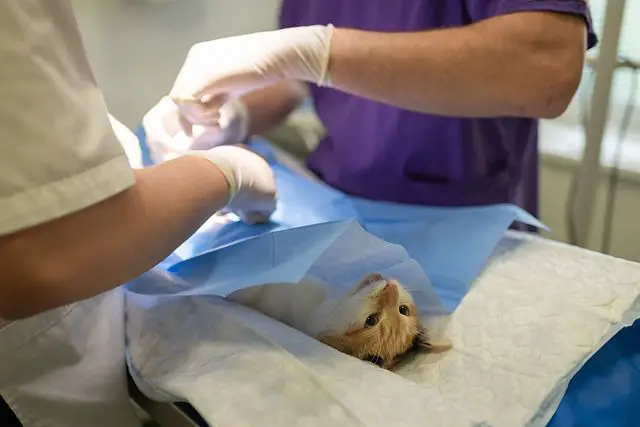How Do Cats Get Ear Mites: 7 Contact Ways, Symptoms & Prevention

Cat owners always ask how do cats get ear mites, in this post as a cat lover and owner, I will outline all the possible ways a cat gets ear mites from experience and research.
Ear mites are a fairly common problem in both cats and dogs. These parasites live on the inside of the ear canal and lay eggs there, so can be quite hard to get rid of.
As a cat owner, it’s important to take measures to protect your cat from getting ear mites in the first place.
Whether you have indoor or outdoor cats, it is not uncommon for them to encounter these pesky creatures at some point.
In this post, we will give you tips that you can use to prevent ear mites from occurring in your feline friend’s ears and what to do if they do happen anyway.
How Do Cats Get Ear Mites
Outdoor cats are more likely to get ear mites when playing or cuddling with other mites-infested cats, but indoor cats can also catch ear mites through infested cats’ toys or bedding or mites-infested environment.
Ear mites can also spread from one mites-infested cat’s ears to other cats in proximity.
Mites are particularly common in kittens and shelter cats, so be careful to examine their ears for ear mites as soon as you have a new cat.
It’s essential to get a freshly adopted cat checked up as soon as possible.
What are ear mites in cats?
Ear mites are found all over the world. They’re microscopic bugs that live in your cat’s ear canal.
Ear mites are a parasitic infection that can affect cats, and ear mites cause irritation and inflammation of the skin in the ear canal.
This can lead to a number of symptoms, including head shaking, scratching at the ears, and redness or swelling on the cat’s head.
These symptoms are chronic, so if you notice any of these, it might be time for a vet check-up. This can also contribute to why outdoor cats live shorter than indoor cats.
It is very important to keep your cat inside during cold months to prevent them from getting ear mites again.
Although they do not cause any symptoms in the cat, they can affect their ear’s ability to function properly.
In order to prevent or treat an ear mite infestation, it is necessary to understand what causes them and how we can stop them from happening.
What is the life cycle of the ear mite?
A mite develops from an egg to an adult in around 3 weeks, going through 5 stages in total. Adult ear mites survive for roughly two months and multiply incessantly.
The whole ear mite life cycle occurs on the host animal, however, mites can survive in the environment for a brief period.
Common ways cats get ear mites
A cat scratching its ears and shaking its head is not uncommon.
If you see your cat doing this more frequently than usual, it might be an indication that he or she is infected with ear mites, a parasite infestation.
Here are the common ways cats get ear mites:
Cats can get ear mites in local veterinary offices
Infestations of mites are one of the most prevalent reasons cat owners visit their veterinarians.
No matter how clean your veterinarian’s office is, mites are tiny and efficient at hiding.
Your cat can even get ear mites from getting close to other cats in the vet.
Do be too sure your cat can’t pick up ear mites from the vet when your cat is been examined on the table in the veterinary office.
When you are at your local vet, be sure to also look out for mites and fleas on your cat’s body.
Cats get ear mites from other cats
Ear mites are spreadable to other cats in the home. Even if other cats are not displaying signs of ear mites, they must be treated at the same time.
Due to their lifestyle, cats are the most susceptible to getting ear mites from other cats within their territory.
This is also one of the ways cats get worms from other worm-infected cats.
Cats can get ear mites from other wild animals or infested pets
This is the most obvious. If you have more than one pet, it is simple to determine who is bringing ear mites to your indoor cat.
Even if your indoor cat never goes outside, he or she will definitely get an infection from his or her canine buddy or other pets.
This is why you should prevent mites and ticks on all of your pets, not just those that go outside.
Even a dog that has been treated for mites and ticks might bring live insects and eggs into the house.
Especially if the product does not repel ear mites or if a high number of mites and ticks outside overwhelms the treatment on the dog.
Cats get ear mites from unkept environment
Ear mites are small, spider-like insects that are typically caught via your feline friend’s exposure to the outdoors.
This can include places that are forested or grassland.
Cats get ear mites when they come in contact with a toy or bed of an infected pet
Ear mites are moving parasites that can fall of the ear of cats whilst the cat is playing with toys.
Ear mites can also fall off the ear of an infected pet or cat while sleeping and if another cat comes in contact with such a toy the cat will surely contact it.
Make sure you properly clean your home after treatment of ear mites.
Cats get ear mites from sleeping on old furniture outside your house
Did you know that the majority of indoor cats develop ear mites by resting on old or new furniture you keep outside your house?
If you buy furniture or rugs from someone whose pet has ear mites, you may unintentionally introduce them into your home.
If you move into a new home, ear mites from previous pets may be present.
To minimize inadvertent ear mite transmission, spotlessly clean everything.
Cats get ear mites from unkept gardens
If your cat frequently wanders through the flowers or gardens in your house, he or she may become infected with ear mites.
Parasites are prevalent in flowers and grasses, and if an indoor cat wanders through them, it will come into touch with them.
An indoor cat may parasitize your property by rubbing its body against the flowers or grasses. This is also one of the ways cats get fleas.
Symptoms of ear mites in cats
Ear mites are incredibly small but can be seen by human eyes, apart from seeing these ear mites here are other symptoms of ear mites in cats:
- Presence of skin problems like scabs around the cat ears.
- Consistent or constant head shaking in cats.
- Persistent or continues scratching at ears in cats.
- Crusty discharge from the cat’s ears.
- Debris in the cat ear canal looking like coffee grounds.
- Redness of the skin around the cat ear canal.
- Inflammation of the cats’ ear canal.
- Unnecessary strong odor coming from the cat ears.
- Excessively itching or rubbing of ears in cats.
- Continues hair loss around the cat ears.
Diagnosis of ear mites in cats
When ear mites are detected in a sample of ear discharge examined under a microscope, the diagnosis of ear mites is confirmed.
Mites can also be observed as little white specks moving around in the ear when using a magnifying scope to examine the ear by the qualified vet.
It is important to confirm the existence of the mites in order to identify ear mites from other ear infections, therefore do not attempt to diagnose yourself.
Before commencing any course of therapy, about ear mites always visit a veterinarian for a complete diagnosis.
Treating of ear mites in cats
Your veterinarian will advise you on the best insecticides to use. Several ear medicines are approved for the treatment of ear mites in dogs.
Because no medicine can penetrate the eggs or pupae, therapy focuses on destroying the adult and larval stages.
Your veterinarian has a number of treatment choices accessible to him or her.
Some are topical medicines that must be used on a regular basis, while others are injections (e.g., ivermectin) or single-use preparations such as Milbemite®, Revolution®, Advantage Multi®, Simparica®, or Bravecto®.
Given the circumstances and your preferences, your veterinarian will choose the best course of action.
How to prevent ear mites in cats
Here are some common ways to prevent ear mites attacks in cats:
Check your cat’s ears for mites once a week
Once a week, check the cat’s ears for mites. Place the cat on your lap and gently lift the ear flaps.
Look for dark-colored wax in its ear, as well as any scrapes or scabs around the base of its ear. Check to see whether the insides of its ears are swollen or red.
Regular grooming of your cat keeps them clean and allows you to check for ear mites or ticks. It’s also a great way for you and your pet to bond.
Regular medical check-ups
To keep your pet safe from ear mites, schedule a monthly check-up and ear-cleaning with your veterinarian.
Then, create a bi-weekly reminder to clean your house, kennel, and pet bedding to decrease the possibility of an illness at home.
Use natural ear mites control method
The pungent odor of Cedar Chips repels ear mites, fleas, and ticks.
Sprinkle them in shady areas beneath your porch and patio furniture. Fleas will be kept at bay even if you walk over them.
Keep your cat’s ears clean
Once a week, use liquid ear cleaner and cotton balls to clean your cat’s ears.
Look for cat-specific liquid ear cleaning at your local pet store or online.
Allow the ear cleaner to get to room temperature before placing a few drops in the cat’s ear, taking care not to let the dropper come into direct contact with the cat’s ears.
To assist the cleaner’s work, massage the base of its ear for 20-40 seconds.
Keep your cat environment clean
Ensure that all animals in the home are treated for ear mites. Other pets can serve as a reservoir of infection, ready to reinfect a cat if therapy is discontinued.
Because most illnesses spread from pet to pet, it’s critical to clean and treat the other pets in the house before focusing on the remainder of the cat’s living environment.
Maintain the cleanliness of the cat’s bedding and play area. Once a week, wash the cat’s bedding in the washing machine or by hand.
Keep the cat’s scratching post and lounging area clean by using a spot cleaner or a fabric cleaner.
Wash your cat’s toys in hot water
Toys for the cat should be washed in hot water with a light detergent. Mites may also live in cat toys, particularly those made of cloth.
To clean the toys, soak them in a pail of hot water and mild detergent for 10-20 minutes.
Vacuum your house regularly
Clean your entire house on a regular basis. Reduce the likelihood of mites in your area and on your cat by cleaning your house on a weekly basis, vacuuming, sweeping, mopping, and dusting as needed.
Vacuuming on a regular basis is especially crucial if you have carpet since mites may burrow and dwell in it.
Keep in mind that mites do not pose a threat to people, but they can readily spread from pet to pet or from textiles to pets.
Keep your cat indoors as much as possible
Keep your cat as much as possible indoors. Cats who spend a lot of time outside are more susceptible to mites and other parasites.
Keep the cat indoors at all times and only allow it out on a leash in a confined location on occasion.
Most cats don’t mind being indoors if they have plenty of space to relax or a play area with a scratching post to keep them entertained.
Wrapping up on how do cats get ear mites
Ear Mites are parasites that live on the skin of animals and humans. They feed on the earwax and dead skin cells found in the ears of their host.
Ear mites commonly cause double ear infections in cats, particularly kittens, and ear mite-infected cats have red, swollen, itching ears.
Another telltale indication of ear mites in cats is dark brown or black discharge in the ear that resembles coffee grounds.
Ear mites often go untreated for months or years because they may not cause any symptoms.
If there is an infestation, it will usually show up as a dark liquid around the ear canal, itching, scratching, head shaking, and sometimes drooping ears.
Treatment involves cleaning out the ear and applying medication to kill the mite eggs and adult mites.




![How Do Cats Get Bacterial Infections [12 Hints] How Do Cats Get Bacterial Infections](https://petcreeks.com/wp-content/uploads/2021/03/How-Do-Cats-Get-Bacterial-Infections.jpg)

